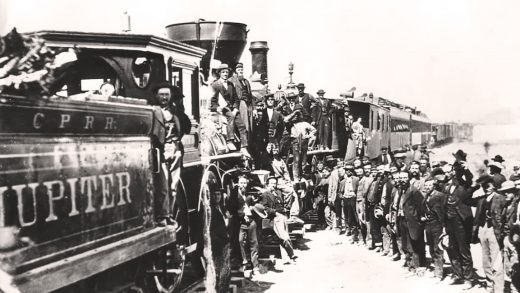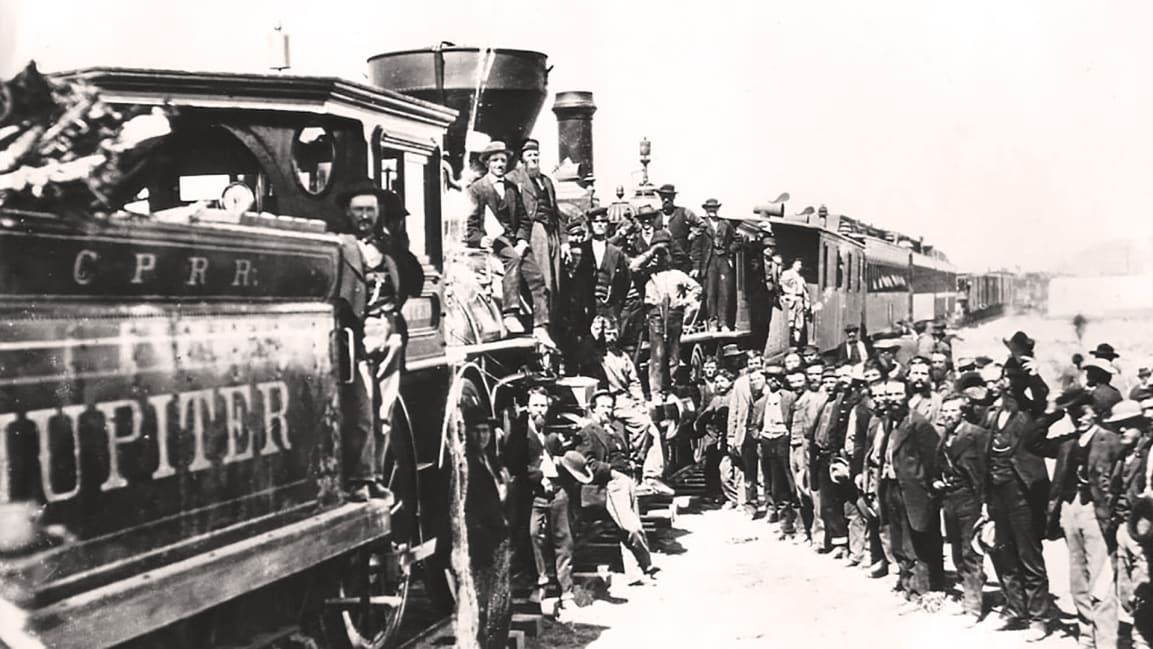The roots of digital racism date back to 19th-century railroads
Americans’ introspective gaze is not what you’d call “unflinching.” The flinch, especially from matters of race and racism, is kind of our thing. But recently, even well-practiced flinchers have seen things that are hard to ignore.
We’ve noticed new maps showing local viral and thermal hot zones that traced the shadowy outlines of redlined neighborhoods from the century before. We’ve worried that facial recognition technology fails to resolve Black and brown faces, perpetuating and refreshing historic patterns of erasure and exploitation. We saw Jim Crow showing up in biased algorithmic decision-making from housing to online shopping to law enforcement—The New Jim Code, in Ruha Benjamin’s phrasing. Digital redlining, as Safiya Noble put it. Even a new book, Your Computer is on Fire, begins with the recently-self-evident prompt that it’s “time to pay attention to the inequality, marginalization, and biases woven into our technological systems.”
Our contemporary concerns reveal a history following structural and systemic patterns, whether our networks transmit data or people and cargo. The digital bias we find in the computer age follows from the racist underpinnings of the earlier transcontinental network: the internet is railroads. Addressing digital racism requires excavating that past.
One damn thing on top of another
Despite the sense that history is one damn thing after another, the visual metaphor of a sequence is wrong. It’s one damn thing on top of another. When we find that railroad infrastructure provided the language for telecommunications networks, even down to the word “online” itself, it isn’t a quirky analogy but an association that binds the two. When we find a nation of easements and rights-of-way beside rails–land that had been secured forcibly and/or disingenuously across the continent–we acknowledge how twentieth-century fiber optic cables overlayed nineteenth-century telegraph lines. These are notices that the layer of digital networks is built on top of, not beyond, the steam-based ones.
The Germans have it right. Their word for history is die Geschichte, which contains the word Schicht, meaning layer. More broadly speaking, history is a palimpsest: old texts remain buried beneath, faint or invisible. Technically speaking, a palimpsest is reused parchment, material that was so precious that authors would erase and write over prior texts on the same page. Writing over old surfaces was practical, just as etching new layers onto older history is metaphorical. It suggests that all writing happens in the presence of other work. “The surface of the earth is soft and impressible by the feet of men,” wrote Thoreau, “and so with the paths which the mind travels. How worn and dusty, then, must be the highways of the world, how deep the ruts of tradition and conformity.”
The palimpsest metaphor is especially attuned to the history of technology, giving us two ways to understand who we are in technological society. In one way, it challenges surface-level triumphalist narratives by asking us to recognize how much new work is written along the grooves of prior work, helping debunk the myth of the Great (usually white) Man Innovator. We teach engineers where, in class, the palimpsest metaphor is important because it forces circumspection and humility, as we sit on the shoulders not just of giants but of everyday laborers. In a second way, the palimpsest is about recognizing that some aspects of the history of technology are buried—”hidden figures” whose “untold stories” must be disinterred.
Redressing twenty-first century struggles with digital racism means acknowledging its layers. And for the internet, that means going back to the industrial revolution and to the trains and wires that undergirded it.
Start by appreciating the distinctly racialized history of the railroad in the 1800s. In India, British Imperialists strung telegraph lines first, then built the rails to follow so communication control would lead to territorial control. They did much the same in southern Africa. In North America, the rail provided a substrate for the United States’ colonial conquest—Manifest Destiny—with telegraphs threaded alongside for measures of safety, communication, and control. When rail magnates built new paths to the west, large train depots found their homes in old cattle towns, Kansas City, Topeka, Dallas, meaning the rail network sat on top of the agrarian movement of animals before. Even then, these were networks written onto networks.
Just as we moderns glorify the almighty app and overestimate our tech titans, the heroism of the nineteenth century rail was written into the template of American cultural identity in ways that obscured the deeper lines of marginalized labor and inequality.
The central chapter of this hagiography was the completion of the transcontinental railroad. You may recall from old high school exams that it was rail tycoon Leland Stanford who placed the final spike in Promontory, Utah, in 1869, completing the promise of continental expansion. It linked rails laid by Chinese, Irish, Black, and Native laborers, some of whom were protesting their work conditions at the time, a development little noted in the Utah hype. Electrified telegraph wire broadcast the hammer strikes driving the final spike into place, though Stanford himself swung and missed, leaving another anonymous worker to complete the job. A one-word telegram, “done,” followed to alert the nation.
This triumphalist story of Peak Manifest Destiny minimizes and overwrites the workers whose labor was invisible—those high school exams center the spike, not the workers, and while Black Pullman porters serving white passengers were visible, Black laborers, brakemen, and fire men were not. The surface-level story also hides the narrative of those who were displaced from the land newly crisscrossed with technology. The metaphor of burial is literal, too, of course: thousands of deaths along those rail lines left laborers—specters of conquest and technological “progress”—buried underneath. One of the iconic images of the era illustrated its slogan, “Westward the Course of Empire Takes Its Way,” as a palimpsest. The “civilizing” railroad draws our eyes to the industrious bustle of a rail town, as the scene to the right shows what is being written over. Frances Flora Bond Palmer’s widely reprinted image avoided subtlety: the locomotive’s smoke blows directly into the faces of an Indigenous duo on horseback.
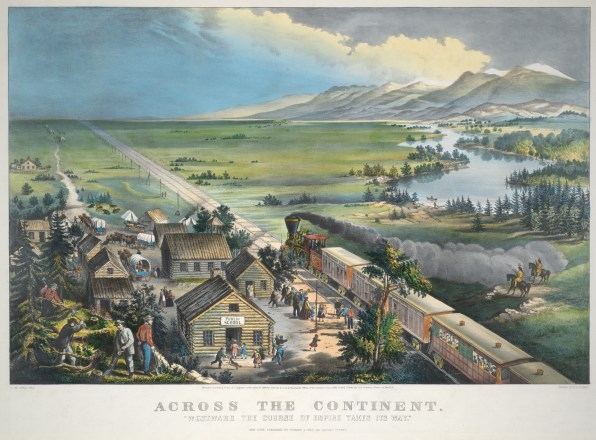
American technological colonialism provided the grooves into which new systems were etched. Racial oppression was part and parcel of the railroad’s development. Those etchings were worn in even deeper in the move from mechanical to digital.
From Alexander Graham Bell to TikTok
Consider the current telecommunications giant American Telephone & Telegraph, which coalesced in 1880s from the company Alexander Graham Bell had founded. Then think of Bell’s other long-lasting legacy, Bell Laboratories, the near-mythic R&D mecca founded in the 1920s that gave us the laser and the transistor—a germanium semiconductor and mid-century artifact co-invented by William Shockley—and earned nine Nobel prizes. In the 1950s, with one of those Nobels in hand, Shockley absconded for California with a team of engineering all-stars where they moved one row up the periodic table to semi-conduct with silicon instead. That shift in choice of metalloid would beget the eponymous valley.

[Photo: Daderot/Wikimedia Commons]
Things then moved quickly on top of networks laid the century before, in ways that wrote into Silicon Valley a template to move fast and break things. Shockley’s star recruit, Robert Noyce, soon defected with a gaggle of cohorts to start their own company, Fairchild Semiconductor. So many new companies then splintered off from Fairchild—one of them being Noyce’s Integrated Electronics, known as Intel—that onlookers called them Fairchildren. Their early success came principally from tax-payer funded government contracts, though the myth of their success carried a libertarian streak. Like the rail tycoons whose success followed from government land grants and military escorts, the Fairchildren somehow erased social memory of the enormous public investment that made their private fortunes possible. In both cases, the romanticized notion of the individualist innovator buried the public stake along with the hidden figures. It’s an erasure historian Nathan Ensmenger points to as central to the mythos of today’s “tech” culture as he explains how Amazon and twenty-first century digital services live on the backs of material networks built long ago.
The proximity of Silicon Valley to Stanford University wasn’t a fluke. The Palo Alto school was founded with swing-and-a-miss Leland Stanford’s money. Railroads didn’t just overwrite networks with telegraphs and then telephones. Rail money also underwrote Stanford University, which incubated so many of the Fairchildren’s children and played a crucial role stitching together the network of networks that became an inter-network simply called The Internet.
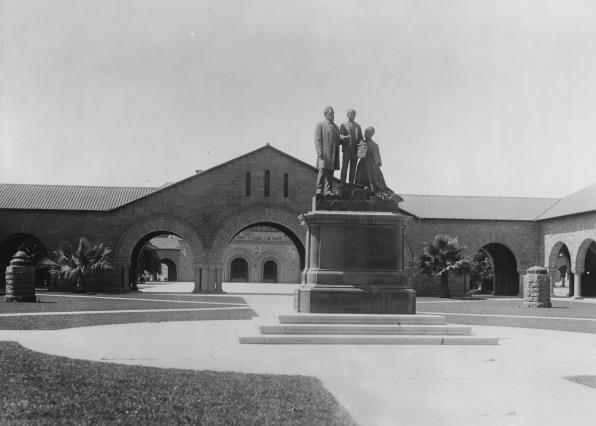
[Photo: University of Southern California. Libraries and /California Historical Society/Wikimedia Commons]
Among the faculty at Stanford was one William Shockley, who began teaching after his employees had defected. Shockley himself held virulent racist beliefs, a racism that can’t be bracketed off and held apart from (or overwritten by) his technological advances: it remains buried in the culture of systems he helped build, just as it was baked into the frameworks he followed. (At Wired, Scott Rosenberg asks of problematic dot-com culture: Is it all Shockley’s fault?) And, along with those of Fred Terman, his eugenics-tinged lessons helped educate future engineers and tech moguls at Leland Stanford’s school. Seeing their common historical membership, Ingrid Burrington notes in The Atlantic how haunted the digital layer is by the mechanical one, how “looking for network infrastructure in America is really [looking for] ghosts.”
Technological colonialism isn’t in the past; it’s under our feet. Thus, when we log onto the network we are jumping on the tracks. More to the point, when we uncover racist structures in what was once cheerfully called the information superhighway, we acknowledge our place in a many-layered history. The modern features of internet communication were built in the grooves of railroad networks, financially, intellectually, and even physically.
A corporate acquisition by T-Mobile just last year gave us an archaeological chance to see those grooves exposed and then re-inscribed. T-Mobile is a telecommunications giant descended from German postal networks. It sought to better compete with its two biggest rivals, AT&T and Verizon, by subsuming Sprint in April 2020. In this transaction, customers not only lost the chance for more yellow-hued ads; they also lost a key connection to the ways modern technological systems overlap and overwrite themselves. The end of Sprint obscured a bit of history by scrawling over it in T-Mobile fuchsia. Meanwhile, The New York Times proclaimed that a new wireless giant was born, mythologizing as “new” “born” an industry that was simply the topmost layer in der Geschichte.
That erasure was not incidental to the palimpsest. Sprint’s origins were in steam-age networks. For a century, the Southern Pacific Railroad leveraged its taxpayer-supported land holdings, with rights-of-way along its tracks. In an effort to write another layer into its history, the SPR buried microwave lines to build newer high-speed communication paths that followed the trains. This became a newly named grid. They called it Southern Pacific Railroad Internal Networking Telephony, which morphed into its 1970s acronym SPRINT.
There are more pieces that brought us from the telegraph to the semiconductor—and from there to microprocessors and microchips and motherboards and dial-up and wi-fi and TikTok. But, while the path wasn’t pre-ordained, it was that with least resistance, as “the ruts of tradition and conformity” provided the framework, methods, and inequalities that made later developments possible. And so the internet is railroads: it’s the resemblance, the resonance, and the racism. The network wrote over its prior iteration. By disinterring this history, we may reveal both what’s been buried and how to build something truly new.
It’s possible that work of disinterment is gaining traction, as 2020 was not only a year for appraisal of the layered structures of history but, aptly, a year of clarified vision. Americans grappled with the historical roots of racial injustice, looking back through Jim Crow and redlining and slavery itself to understand disproportionate impacts of viruses, policing, biased algorithms, and climate change on historically marginalized populations. It was a year of digging as much as reckoning. It might not have taken so long, but for the persistence of a mythology bent on valorizing the progress of the smoke while keeping those coughing up toxins out of view in the corner. Or buried underneath. “Most Americans have never heard of settler colonialism, much less used it to describe their country,” writes novelist Viet Thanh Nguyen. “That’s because Americans prefer to call settler colonialism the American dream.” In Priya Satia’s terms, we are “hostage to myth.”
One such tall tale of white heroism was the Underground Railroad which was itself, to use Kathryn Schulz’s phrase, “not quite a myth, but mythologized.” At its dawn, the rail’s cultural meaning was so prominent, so taken as given, that it gave rise to its own metaphors. An “underground” railroad would be hidden, buried, invisible. Harriet Tubman and her collaborators knew what they were doing.
So did Colson Whitehead in the narrative choice to materialize the metaphor in his Pulitzer Prize-winning novel. In The Underground Railroad, a character marveling at the ingenuity of the physical system wonders who could have built it. A station agent drily replies, “who builds anything in this country?” The unspoken answer: enslaved people whose labor powered industries, whose work made economic prowess possible for other Americans. Whitehead makes slavery itself a machine: “It was an engine that did not stop, its hungry boiler fed with blood.” “The ruthless engine of cotton required its fuel of African bodies … The pistons of this engine moved without relent.”
Beneath the shiny newness
The twenty-first century digital economy is not such a clean break from past technological eras; it’s built not beyond but merely on top of the earlier networks. Things are not so novel as the disruptors, the would-be Great Men, would have us believe. AT&T and Sprint both carry within them the dual communication-transportation nexus of their origins. To cinch the point, the historian Nathan Ensmenger’s map illustrates the overlay of the NSFNet (the early internet) on top of the Southern Pacific Railroad paths. Not shown but also present are data centers housed in small towns like Council Bluffs, Iowa, as Burrington explains, an otherwise odd choice but for the fact that it was the eastern terminus of the Union Pacific Railroad. It was always thus.
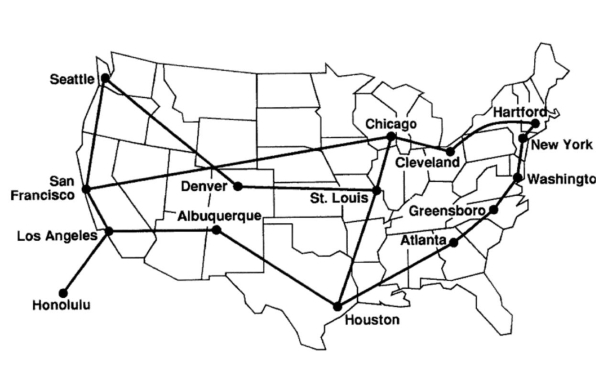
The racism undergirding the rail networks is the racism inside digital bias. It plays out in both senses of the palimpsest as something buried beneath and as permitting today’s tech gurus to be celebrated and rewarded mainly for being the most recent to add a layer. With trains, it was the labor that built the network, the workers along the lines, and the peoples displaced and killed along the way; with the internet, it is likewise the labor that’s gone into building the networks as well as the forms of discrimination built into the structure by code and algorithms.
To the labor point, we shouldn’t have to wait fifty years to learn about the Black women whose calculations permitted NASA’s Mercury 7 to become national heroes, but who remain best-known as “Hidden.” Nor to “discover” decades later that “Latina/o information workers have been essential to the telecommunications industry since the 1970s,” as Joy Rankin explains. Nor to dig up contributions of Black computer networking and coding pioneers, described in Charlton McIlwain’s Black Software: contributions that have been buried under the dominant narrative of young white men tinkering in garages.
To the structural point, when we talk about systemic racism, this is it: these are the systems. Nineteenth century infrastructural commitments and acts of burial lie in wait as we confront the racist dynamics of the age of coding, algorithms, and social media. Erasures, we call them, when writers take the pink end of their pencils to rub out the markings of the past.
When we fixate on shiny newness, we neglect to consider the people, events, context, and values of history in deeper layers of the palimpsest. Yes, to echo a common refrain, STEM students should learn STEM history, but they must also reckon with the embedded, encoded values in technologically layered history. It’s unlikely you’ll think to build an anti-racist social network, for example, if you don’t appreciate how deeply entrenched racist values are in the current ones.
Thoreau’s ruts suggest a tension point: the deepened grooves of tradition and conformity are the stories we keep telling—the myth that great white men built this world, for example; the myth that ours is an era far beyond (not just atop) prior ones—but we can beat a new path by appreciating the palimpsest and recognizing the buried details.
It is, of course, a difficult path. Last year, we were reminded that those who reveal that which has been concealed are not rewarded for their efforts when Google forced out its lead AI ethicist, Timnit Gebru, apparently for working on AI ethics. Big tech is as comfortable in its well-established ruts as big rail before it: too many baronic bros are indifferent to the labor conditions of their workers, and to the broader impacts of their work. Big tech, that is to say, flinched. But without such revelation, exclusion, overwriting, and erasure remain the default. To progress toward justice, we must excavate and dismantle those structures that rely on and perpetuate racism.
Jenn Stroud Rossmann, a professor of mechanical engineering at Lafayette College, writes the essay series “An Engineer Reads a Novel” for Public Books. She is also the author of the novel The Place You’re Supposed to Laugh (7.13 Books, 2018) and the coauthor of the textbooks Continuum Mechanics for Engineers: 4th Edition (Routledge, 2020) and Introduction to Engineering Mechanics: A Continuum Approach (CRC Press, 2015).
B.R Cohen is an associate professor at Lafayette College, where he teaches courses in history, environmental studies, and technology studies. He is the author of Pure Adulteration: Cheating on Nature in the Age of Manufactured Food (Chicago, 2019) and, most recently, co-editor of Acquired Tastes: Stories about the Origins of Modern Food ( MIT, 2021).
(43)

